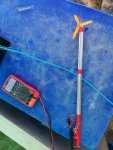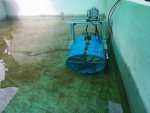That schematic is quite interesting, and I guess one of the most interesting thing about it is how complicated it appears to be. I remember from one of the articles I read recently about this particular pond (after you mentioned it) they talked about an upflow biological filter shaft. Now that I see the schematic, I think I can visualize it much better.
I'm definitely trying for a much simpler design. If I can, I'll try to draw up a presentable schematic of what I am working towards over the next few days to open it up to any suggestions. But the basic idea was to target simplicity of maintenance over reducing the amount of maintenance. While I don't have much experience with this particular kind of project, the various engineering projects I've done over the years (soccer playing robots, autonomous vehicles, computer vision systems, security systems, electric vehicles) has taught me that when you are doing something for the first few iterations, many things will go wrong. The designs that end up working best in the early iterations aren't the most sophisticated, but rather the ones that make it easiest to fix the things that go wrong. I guess if you are BioNova, you've gone through these early iterations and worked many of the engineering kinks out and can implement more advanced designs.
In the beginning I was actually planning an upflow system just because that was what the first DIY resources I found seemed to show. Then I ran into a few downflow designs and realized I liked them more. This page has a simplified schematic I stumbled across a while back:
http://www.ecohome.net/guide/natural-ponds-natural-swimming-pools
For the pond design, I reasoned (rightly or wrongly?) that since on an upflow, you are pushing water into the filter from small holes in a pipe at the bottom, you would have a greater chance of particles clogging up the pipe. And the clogs would be in a very hard to reach location. Thus the backflushing. But I always worried the backflush would only unclog a small percentage of the holes, leaving it susceptible to clogging again in short order. In a downflow, the particles "enter" the filter on the surface, and thus should get trapped somewhere in the much larger area of the top of the substrate, which is unlikely to ever clog. And any buildup on the top of the substrate will be easily accessible for maintenance and cleaning anyway. Put another way, only filtered water ever touches the hard to reach parts of the pipe.
As a secondary advantage, the general flow of water on the surface would be from the swimming area to the planted area, so this might have a slight "retaining" effect on the floating plants, keeping them in the planted zone. I'm not sure if the flow rates are enough, though. A rough calculation suggests an average of about 1.5cm/second of water flow rate above the retaining wall based on my pond configuration if I target a 1 day turnover rate.
I suspect that the design I went with is really the same as the subsurface flow wetlands you described, just with the water direction reversed. I have perforated pipes in a gravel layer meant to allow the water to flow horizontally toward the pipes after the water seeps downward through the sand. If the pump were reversed, the gravel layer would allow the water to flow horizontally away from the pipes to spread out before seeping upwards through the sand. Or am I missing some more fundamental conceptual difference here?
As a side note, the "Thai long tail boat propeller" based circulation pump prototype we've been building is almost ready for testing. The entire thing has cost in the range of $50-$100 so far, including custom machining for couplings, etc. If I'm lucky, I'll be able to test it by the end of the week. I'll try to post some pictures. (And numbers.) Because it is only circulating the water horizontally rather than pumping upwards, I'm estimating the the large 12" propeller will only have to rotate at around 100-150 rpm to get the approximately 30 liters per second (30,000 gallons per hour) flow rate I'm targeting. The large, slow impeller should result in much higher efficiency. And maybe it is less likely to get clogged by any small debris that does happen to end up in the pipe. (Small pieces of gravel that make it through the holes?) At least that is the theory. We'll have to see for real when it is operational.
Also, does anyone know where to source a cheap "river water flow meter" that I can use to test the flow rate at the exit of the circulation pump? The only ones I found for sale here in Thailand were around $7,000 when I asked for a quote. It looked like a toy boat propeller on the end of a stick connected to a simple magnetic encoder. Here is a link to a similar one:
http://www.vernier.com/products/sensors/flo-bta/
I suspect we could build a simple one for around $20-$30, but this will take some more time. (And will need to be calibrated somehow.) I really don't need a $7000 precision instrument. Is there any cheap tool like this for sale on eBay or anything? I looked and couldn't find one. The only ones I saw are the kind that go in a small pipe as part of a household water system.
http://www.ebay.com/bhp/water-flow-meter
II can't think of how these can be made to work for measuring flow rates in the pond. :-(







